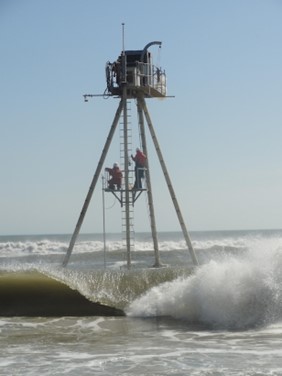CRAB 2.0 – DLBA’s Modern Take on a Coastal Research Classic

DLBA recently completed the preliminary design of a Next-Generation Coastal Research Amphibious Buggy (CRAB 2.0) for the US Army Corps of Engineers Coastal Engineering Research Center’s Field Research Facility in Duck, North Carolina. The design of the CRAB 2.0 is based on the existing CRAB used by the Corps at the Duck facility for over 40 years. The CRAB is used to perform surveys on the ocean floor, maintain sensor equipment, and provide a stable platform in the surf for other scientific work performed in Duck.
With only two known CRABs operating today, and a handful ever built in the United States, DLBA was faced with the question, “How does one design a CRAB?”
To solve for this design challenge, we initially tasked ourselves with evaluation of what makes the existing Corps CRAB such a useful piece of equipment. We performed a detailed survey on the CRAB, took a ride out in the surf, and essentially reverse engineered the existing CRAB. Key elements of this effort were the development of a new stability analysis methodology that compared forces applied from surf zone waves to the CRAB’s resistance to tipping, and a comprehensive trade study on propulsion options, where we studied all propulsion and power options available to design a new CRAB.
Once the existing CRAB was evaluated and understood, DLBA began the preliminary design of CRAB 2.0. Size, system integrations, and safety were all evaluated and improved upon. First, CRAB 2.0 was designed to be taller than the existing CRAB to allow operation in deeper water. Because the existing CRAB was modified at different times over its 40-year lifespan, the next step was to integrate many of the systems from the existing CRAB into a new comprehensive design. This included design of a sensor handling system and a movable platform system and integration of the associated structural members into the CRAB design. A space frame finite element analysis was performed on the structure. This allowed DLBA engineers to optimize the structure for weight, strength, and stability. A new diesel-hydraulic propulsion system was designed. The key features from the existing CRAB were retained and new features were added to increase the reliability and reduce maintenance costs on the system. Finally, key safety improvements were made over the existing CRAB. The addition of fall protection, standard toe rails, and other systems that aid in safe CRAB operation were included.
The CRAB 2.0 preliminary design gave us a challenge of a unique project that is outside our widely-known core capabilities – for example, boats are meant to float, and if the CRAB floats we have a serious problem! DLBA engineers rose to the challenge to provide the customer with an optimized design that will allow for another 40 years + of CRAB operation for the US Army Corps of Engineers.
Image Courtesy: USACE
